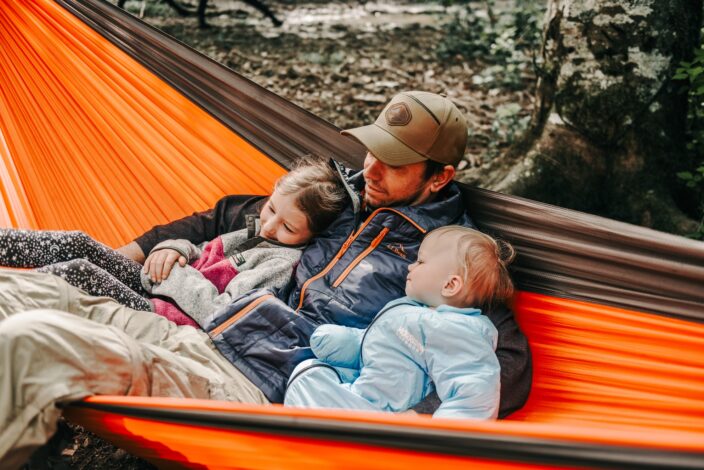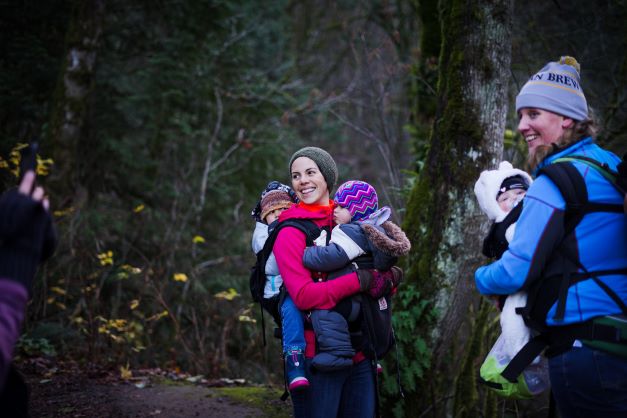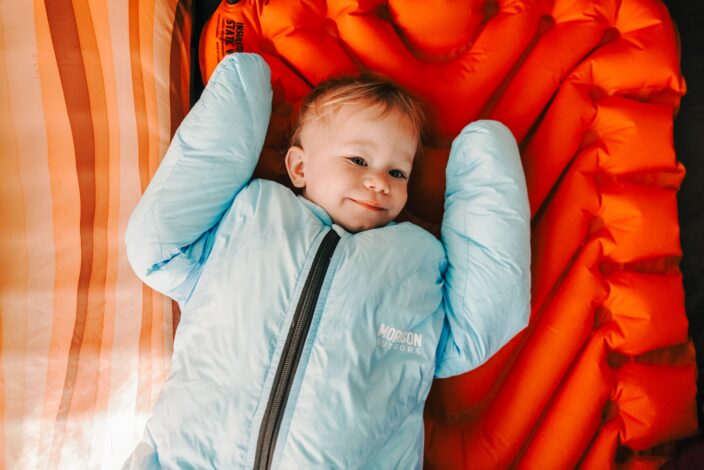How to Dress Baby for Cold-Weather Camping
IN PARTNERSHIP WITH OUR FRIENDS AT MORRISON OUTDOORS
The term “camping” may bring to mind warm summer nights and hot days splashing in the lake. However, there are benefits to camping in colder weather. There are fewer crowds, it’s easier to find prime campsites, there are not as many mosquitoes and biting bugs, and bedtime is less of a struggle since there are fewer hours of sunlight (just to name a few). So why don’t more families camp in colder weather?
The biggest question we get from caregivers is “How do we keep our family warm when camping in colder weather?” followed by “there is no way I could camp with my baby in this weather!”. We promise you, it is possible, even with a young baby in tow. It’s all about the right layers and sleeping environment. Read on for more information on how to layer your baby for a cold-weather camping adventure and start reaping the benefits today! 
The Basics of Layering Baby for Cold-Weather Camping
Choosing the right material and number of layers is crucial for keeping your baby (and everyone) warm during cold-weather adventures. Here are some basics to keep in mind when picking cold-weather camping clothing:
Base Layers for Baby
First and foremost, AVOID COTTON! There is a reason you hear the term “cotton is rotten” when it comes to winter clothing. It collects and holds on to moisture which can then chill the skin when it’s cold. This is especially dangerous for babies since it can lead to a drop in body temperature. For the layers closest to the skin, we highly recommend wool for its soft feel, durability, and superior wicking ability. Synthetic materials (such as polyester) are also effective and generally a more budget-friendly option. Various companies make baby-specific base layers that include a onesie and leggings. Insider tip: if you choose a onesie option, snapping the onesie over the leggings can help prevent the leggings from sliding down while baby is moving around or being carried.
Middle Layers
This layer goes right on top of the base layer and functions as an insulator to help retain body heat. Polyester fleece is a great, affordable option here, especially fleece footie pajamas that completely cover the baby’s feet. One thing to note: if you plan to babywear your child during your camping adventure, make sure the footie pajamas are not so tight that they could risk reducing circulation (I usually went a size up if I was wearing my kiddos). Other options include thick-knit wool or insulated down, which are very durable but also come with a higher price tag. 
Outer Layers
The type of top layer you choose will rely heavily on two factors: temperature and moisture. For the really cold, wet adventures, you may opt for a waterproof, down, one-piece snowsuit. This provides full protection from the elements, but also limits mobility and can make your baby too warm if the temperatures rise (in this case, you can shed the mid-layer). For cool or cold (but not frigid) camping trips, a down or synthetic jacket on top will likely suffice. I highly recommend purchasing a waterproof one-piece shell (such as a rain suit) for baby in case the weather turns wet. Look for ones that cinch on the waist, ankles, and wrists so you can size up and let your baby grow into it.
Accessories
Wool is an excellent material for hats and socks to keep moisture away from the skin. Synthetic material is an affordable option as well, just stay away from cotton! My kiddos wear these at night as well since they tend to wiggle in their sleep (my oldest used to wiggle completely out of his sleeping bag!). If you don’t want to purchase wool baby socks that they will grow out of quickly, you can use big-kid or even adult wool socks on your baby’s feet and hands to keep little extremities warm. Fleece is a great option for gloves if the conditions are not wet and your baby prefers a bit more dexterity. They also layer well under waterproof gloves for some added warmth and protection. Wool or fleece scarves or neck warmers are a wonderful option for added insulation, just be sure to make sure they are loose and not constricting the baby’s airway. Proper footwear for your baby will depend greatly on outdoor temperatures and the mobility of your little one. Warm fleece or wool booties may suffice if your little one isn’t walking yet. Winter boots may be a better option for little walkers so they keep their feet dry and clean while traipsing around the campsite or trail.
Keeping Warm Through the Night

Once the sun sets, the temperatures can drop significantly. A baby-specific sleeping bag is a must for keeping your baby warm through the night. We love the Morrison Little Mo for babies 6 months and older. There are two temperature ratings to choose from: A synthetic 40-degree option and a down 20-degree option. You can find out more about these sleeping bags in this article. In addition, make sure your baby is not sleeping directly on the floor of the tent. A camping crib/pack and play or sleeping pad can provide insulation from the cold ground and help baby sleep more soundly.
Does your family enjoy cold-weather camping adventures? Do you have tips to make it enjoyable and successful for the whole family? Let us know in the comments below! Looking for more information on how to camp with a baby in tow? Stay tuned for more articles in this blog series! We will cover various topics and provide tips and advice to make camping with a baby a huge success!
Other Articles in this Series:
- How to Choose a Baby-Friendly Campsite
- Essential Baby Camping Gear
- Tips for Sleeping in a Tent with Baby
- Favorite Baby Camping Foods
Photos by Deanna Curry and Kim Ives
ABOUT OUTGROWN
OutGrown is a 501(c)(3) nonprofit that works to create a world where everyone can enjoy the physical and mental benefits of spending time outside. We are focused on creating opportunities and removing barriers to access so families with babies and young children can take their first steps outside. We believe all families have the right to connect with nature, benefit from spending time outdoors and be inspired to a lifelong love of nature. Since its grassroots inception in 2013, OutGrown is a growing community of 280,000 families and over 300 volunteer Branch Ambassadors. More information on all of our programs can be found at WeAreOutGrown.org
EDITORS NOTE:
We hope you enjoyed reading this article from OutGrown. We’re working hard to provide our community with content and resources that inform, inspire, and entertain you.
But content is not free. It’s built on the hard work and dedication of writers, editors, and volunteers. We make an investment in developing premium content to make it easier for families with young children to connect with nature and each other. We do not ask this lightly, but if you can, please make a contribution and help us extend our reach.
Related Content




Comments